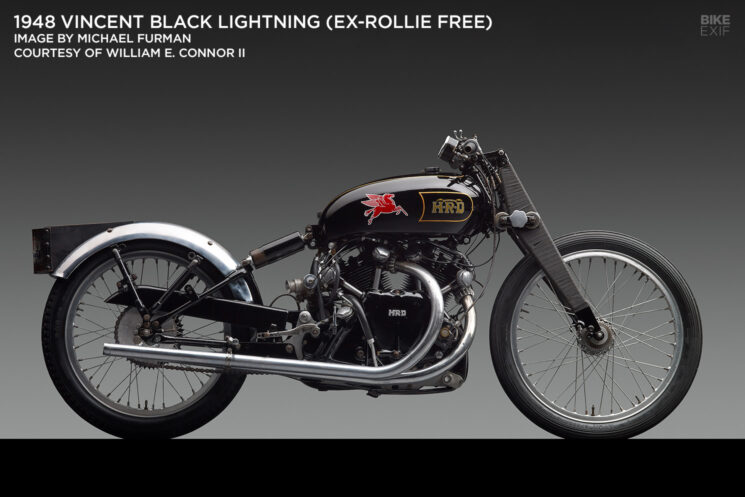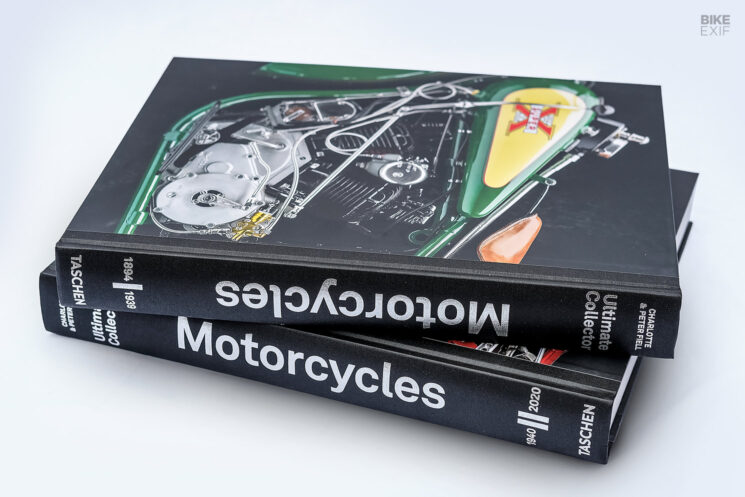
In the realm of classic motorcycles, terms like ‘rare’ and ‘expensive’ are objective. If very few examples of a particular bike remain, it’s rare; if acquiring one will cost you an arm and a leg, it’s expensive. But terms like ‘iconic,’ ‘legendary,’ and ‘mythical’ are harder to quantify.
Right now, we’re neck deep in a book that makes a bolder assertion, by asking what makes a motorcycle collectible. Authored by Charlotte and Peter Fiell and published by Taschen, Ultimate Collector Motorcycles is a monolithic double-volume compendium of iconic and collectible motorcycles. And it is breathtaking.

Spanning over two volumes and 940 pages, Ultimate Collector Motorcycles features 100 motorcycles, each desirable in its own way, with a total of 1,100 photographs spanning its pages. Each hardcover volume measures 11.5” by 14.5” and is around 2” thick, and the entire package weighs just over 20 lbs. (You can only consider this a coffee table book if the coffee table in question is considerably sturdy.)
The first volume chronicles motorcycles from 1894 to 1939, starting with the 1894 Hildebrand & Wolfmüller and concluding with the 1939 Gilera 500 cc Rondine. The second volume runs from 1940 to 2020, starting with the 1940 Crocker 61 ci ‘Big Tank’ and coming in to land with Aston Martin’s striking 2020 AMB 001. As you’d imagine, selecting bikes for this project was no walk in the park.

“Any selection like this will always be subjective,” Peter admits. “The book is not a history of the motorcycle per se, but we wanted to illustrate the evolution of the motorcycle over the last 125 years by showing the rarest, most beautiful, most historically important bikes in the most original condition out there, which were also the most innovative in terms of their design and engineering. Inevitably, these bikes will be the most desirable, collectible, and valuable in monetary terms.”
Flipping through the pages of Ultimate Collector Motorcycles is like meandering through the halls of a passionately-curated motorcycle museum. Obvious early-century picks include the 1907 Harley-Davidson Model 3 and 1922 Brough Superior SS80, but you’ll find the legendary 1914 Flying Merkel Model 471 and 1919 Indian Powerplus board tracker in there too. Meanwhile, bikes like the 1921 Mars A20 and 1930 Majestic 350 will truly test your knowledge of motorcycle history.

Bikes like the 1934 BMW R7 Prototype recall the golden age of motorcycle design, while Rollie Free’s Vincent Black Lightning is a reminder of how unhinged land speed racers used to be. Racing aficionados will appreciate the smorgasbord of vintage and modern-era race bikes from Honda, Norton, Ducati, Harley-Davidson, Suzuki, Yamaha, MV Agusta, and more. The groundbreaking Britten V1000 lurks in these pages too, as does the impossibly elegant Falcon Motorcycles Black Falcon.
But what really has us glued to the pages, is how vividly each motorcycle is presented. The photography is crisp and immersive, to the point that you feel like you can reach out and touch the patina on some of the more well-worn bikes. Remarkably, 76 of the 100 bikes in Ultimate Collector Motorcycles were photographed specifically for the book—22 of them by our good friend and regular Bike EXIF collaborator, Marc Holstein.

“All of these came from private collections; the majority from the greatest private motorcycle collection in the world,” says Peter. “Images of the other 24 bikes came from either museum collections, photographers’ archives, or Bonhams and Mecum auction catalogs. The images from these latter two, however, needed quite a lot of photo editing to make them compatible with the rest of the images in the book—so even these photos look new.”
The fact that three-quarters of the motorcycles featured here currently exist in private collections adds to the overall mystique of the project—and it underlines the work involved in bringing it to print.

Charlotte and Peter are respected design historians who, in the last 35 years, have authored almost 70 books on industrial and transportation design. Still, it took them two years of full-time work to complete the project, which included selecting the bikes, commissioning photography from 14 different photographers, and sourcing the myriad archival photographs that accompany each bike’s story.
“It was a phenomenal amount of work that turned into a real labor of love,” Peter adds.

The couple also researched and wrote Ultimate Collector Motorcycles’ extensive texts. These include an insightful history of each bike, an introduction to the book, and several entertaining interviews that fill the final pages of the first volume.
The interviews feature the respected (and sharply-dressed) motorcycle historian and founder of The Vintagent, Paul d’Orléans, George Barber of the Barber Motorsports Museum, and the co-founder of the Quail Motorcycle Gathering, Gordon McCall. Also featured are Sammy Miller, championship-winning racer and founder of the Sammy Miller Motorcycle Museum; and Ben Walker, who heads up Bonham’s motorcycle department. The book’s foreword is written by the notorious petrolhead Jay Leno.

The final cherry on the cake is the archival material that’s crammed into the book’s remaining gaps. Wherever possible, each motorcycle feature includes everything from old catalogs and posters to racing photographs and even technical drawings. If you just want to look at pretty pictures of bikes, you could do that for hours—but if you want to dig deeper, you could have your nose stuck in Ultimate Collector Motorcycles for weeks.
If we had to nitpick anything, we’d say that we’re not huge fans of the way the interview section of the book is printed in black ink on a silver background. It makes the reams of text a little harder to read, and in one or two places, it’s clear that the black ink struggled to take to the silver paper. Still, everything is legible enough, and it’s a small blight on an otherwise exceptional publication.

There are also one or two bikes that we’re not sure we would have included. But then again, personal preference isn’t really what this book is about. Once we took a step back and put our personal biases aside, we realized that although we don’t find those bikes desirable personally, they are unequivocally collectible.
Finally, we asked Peter how the publication of Ultimate Collector Motorcycles differed from one of the couple’s previous projects, Ultimate Collector Cars. “One of the most surprising things we discovered while undertaking work on the book was the difference between the collector motorcycle and collector car worlds,” he replies.

“In both cases, we were operating at the top of the market—but for our earlier Ultimate Collector Cars book, not a single example was sourced from a private collection. Despite our asking several well-known collectors, not a single one wanted to share anything at all about their car—or even acknowledge its existence in their collection.”
“The difference to the motorcycle world could not be more stark. Most of the bikes we included in the book came from, without a doubt, the best private collections in the world. These collectors were among the most helpful, sharing, and generous people we have ever encountered. Without them, the book would not have been anything like it turned out.”

You can grab the ‘Famous First Edition’ of Ultimate Collector Motorcycles from Taschen at $250. Limited to 9,000 numbered copies, it consists of two hardcover volumes in a rugged slipcase (as pictured here). If that’s not swish enough for you, you can grab the $850 ‘Collectors Edition.’ Limited to 1,000 numbered copies, it uses aluminum print covers, leather-bound spines, foil embossing, and silver book edges, and each volume has its own slipcase.
Just like the machines wedged between its covers, Ultimate Collector Motorcycles is something worth owning. It’s one of the best (if not the best) motorcycle books we’ve ever come across, and we’d happily recommend it to anyone with even the slightest attraction to motorcycles.
Book images by Wes Reyneke
